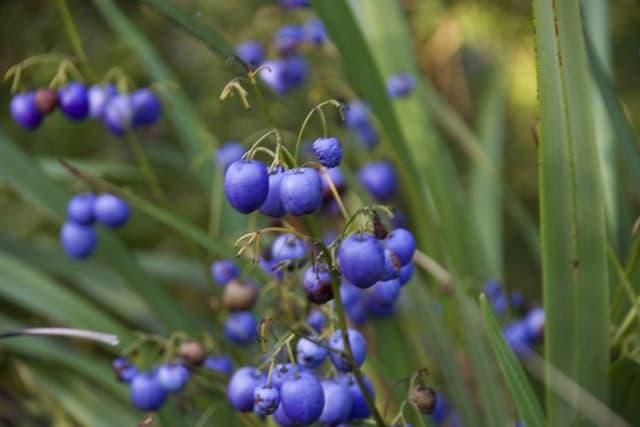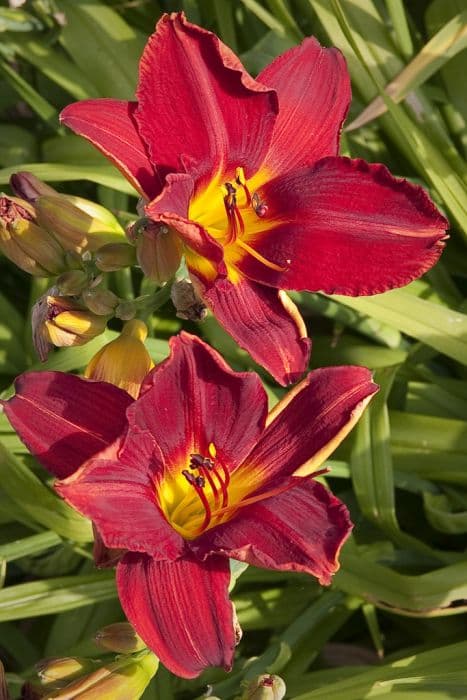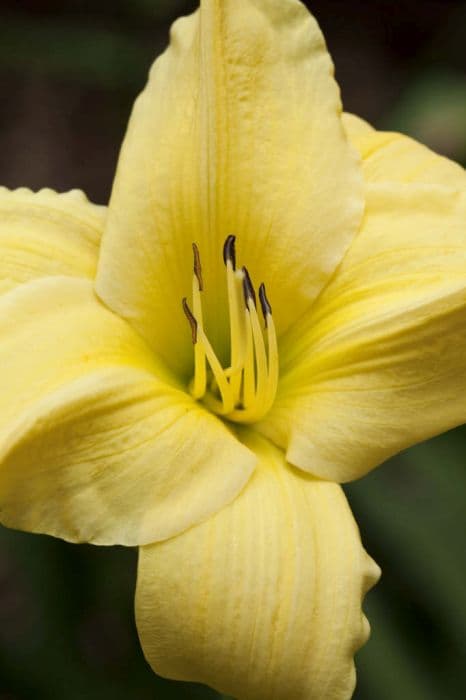New Zealand Flax Phormium 'Yellow Wave' (v)

ABOUT
Phormium 'Yellow Wave', commonly known as variegated New Zealand flax, is a perennial plant known for its striking foliage. It has long, arching, sword-like leaves that are a distinctive feature. The leaves are bold and display a blend of colors; the primary color is a deep green which is beautifully variegated with creamy yellow to light yellow stripes, creating a 'wave' of color across the surface. These bright stripes can add a luminous quality to the plant, especially when backlit by the sun. The variegated leaves are a central attraction, making the plant a popular choice for adding visual interest to garden landscapes, contrasting well with other garden plants. The edges of the leaves are slightly wavy, adding to the textured appearance of the foliage. The plant produces flowers, but it is primarily grown for its decorative leaves.
About this plant
 Names
NamesFamily
Asphodelaceae
Synonyms
New Zealand Flax, Variegated New Zealand Flax, Yellow Wave Flax
Common names
Phormium 'Yellow Wave'
 Toxicity
ToxicityTo humans
The New Zealand Flax is not known to be toxic to humans. However, like many plants, it may cause irritation or an allergic reaction if ingested or if the sap makes contact with skin. It is always advisable to handle plants with care and keep them out of reach of small children who might accidentally ingest plant parts.
To pets
New Zealand Flax is not commonly listed as toxic to pets such as cats and dogs. However, ingestion of non-food items can lead to gastrointestinal upset in animals, so it's prudent to prevent your pets from chewing on the plant. If you suspect your pet has eaten a large amount of the plant and is showing symptoms such as vomiting, diarrhea, or lethargy, you should contact your veterinarian.
 Characteristics
CharacteristicsLife cycle
Perennials
Foliage type
Evergreen
Color of leaves
Variegated
Height
4-5 feet (1.2-1.5 meters)
Spread
2-3 feet (0.6-0.9 meters)
Plant type
Shrub
Hardiness zones
8-11
Native area
New Zealand
Benefits
 General Benefits
General Benefits- Attractive Foliage: Phormium 'Yellow Wave', commonly known as New Zealand Flax, has striking yellow and green variegated leaves that add color and vibrancy to gardens.
- Architectural Structure: Its rigid, sword-shaped leaves provide a strong architectural element to landscapes, suitable for modern and contemporary garden designs.
- Drought Tolerance: Once established, New Zealand Flax is relatively drought-resistant, making it suitable for xeriscaping and low-water gardens.
- Low Maintenance: This plant requires minimal care once established, making it ideal for gardeners looking for low-maintenance options.
- Pest Resistant: New Zealand Flax is quite resistant to pests and diseases, reducing the need for chemical treatments.
- Versatility: It can be grown in a variety of soil types and is tolerant of coastal conditions, such as salty winds, making it a versatile choice for different garden locations.
- Long-Lived: With proper care, New Zealand Flax is a long-lived plant that can provide many years of enjoyment in the garden.
- Attracts Wildlife: The flowers and seed pods can attract birds and other wildlife, adding to the biodiversity of the garden.
- Erosion Control: The root system can help stabilize slopes and prevent soil erosion.
- Container Gardening: It is also suitable for container gardening, allowing it to be featured on patios, balconies, and other areas with limited space.
 Medical Properties
Medical PropertiesThis plant is not used for medical purposes.
 Air-purifying Qualities
Air-purifying QualitiesThis plant is not specifically known for air purifying qualities.
 Other Uses
Other Uses- The fibrous leaves of the New Zealand Flax can be woven into durable textiles such as mats, bags, and baskets.
- This plant can be processed into paper, providing an eco-friendly alternative to traditional wood pulp paper.
- New Zealand Flax can be used in floral arrangements for its striking foliage and can add a tropical flair to bouquets.
- The long leaves of the New Zealand Flax are sometimes used in thatching for small structures, such as huts in thematic gardens.
- The plant can serve as a natural windbreak or privacy screen due to its size and density.
- New Zealand Flax is ideal for erosion control on slopes or banks because of its robust root system.
- The leaves may be used to create natural dye, which can provide a range of green hues for textiles.
- In the garden, New Zealand Flax can be used to tie back other plants or create natural support structures.
- The strong leaves can be crafted into traditional Māori footwear, known as "sandals" for ceremonies.
- Its vibrant leaves can be used in crafts, such as making lanterns or decorative panels when dried and treated.
Interesting Facts
 Feng Shui
Feng ShuiThe New Zealand Flax is not used in Feng Shui practice.
 Zodiac Sign Compitability
Zodiac Sign CompitabilityThe New Zealand Flax is not used in astrology practice.
 Plant Symbolism
Plant Symbolism- Resilience: The 'Yellow Wave' is a variety of New Zealand Flax, a plant known for its toughness and ability to thrive in difficult conditions, symbolizing the ability to endure and overcome adversity.
- Versatility: As a plant that is used for various purposes, from ornamental gardening to the production of fibers, the New Zealand Flax represents adaptability and resourcefulness.
- Beauty in Function: The striking foliage of the 'Yellow Wave', paired with the plant's historical use for weaving, signifies that practicality and aesthetics can coexist harmoniously.
- Growth: The long leaves that grow vigorously embody growth and progression, suggesting a theme of personal or spiritual development.
 Water
WaterNew Zealand Flax 'Yellow Wave' should be watered thoroughly, ensuring the soil is moist but not waterlogged. During the growing season, water it once a week with about 0.5 gallons per plant, depending on the size and the weather conditions. In the winter, reduce watering to every other week or less, monitoring the soil moisture. Overwatering can lead to root rot, so allow the top inch of soil to dry out before watering again. If in a container, ensure it has drainage holes and water when the topsoil feels dry to the touch.
 Light
LightNew Zealand Flax 'Yellow Wave' thrives best in full sun to partial shade. It can tolerate various lighting conditions but for optimal growth and coloration of the leaves, a site that receives several hours of direct sunlight is ideal. Avoid deep shade locations, as this can diminish the plant's vibrancy and weaken its structure.
 Temperature
TemperatureNew Zealand Flax 'Yellow Wave' is hardy and can tolerate a range of temperatures. It prefers to grow in conditions between 65 to 75 degrees Fahrenheit but can withstand temperatures as low as 20 degrees Fahrenheit. Avoid exposing the plant to temperatures above 90 degrees Fahrenheit for prolonged periods, as this can cause stress.
 Pruning
PruningNew Zealand Flax 'Yellow Wave' should be pruned to remove any dead or damaged leaves as needed to maintain its appearance. Prune in the spring or early summer to encourage fresh growth. Propagate by division or cutting back older plants if they become too large, doing so every few years. Pruning is not only aesthetic but also promotes vigorous growth and can rejuvenate an older plant.
 Cleaning
CleaningAs needed
 Soil
SoilNew Zealand Flax 'Yellow Wave' thrives in a well-draining soil mix composed of loamy or sandy soil enriched with organic matter. It prefers a slightly acidic to neutral pH, ranging from 5.5 to 7.0. A mix of two parts garden soil, one part peat or compost, and one part perlite or coarse sand is ideal for maintaining good drainage and providing nutrients.
 Repotting
RepottingNew Zealand Flax 'Yellow Wave' typically doesn't need frequent repotting and can be done every 2-3 years. It should be repotted when it outgrows its current pot or the soil becomes compacted, which can impede drainage and aeration.
 Humidity & Misting
Humidity & MistingNew Zealand Flax 'Yellow Wave' is adaptable to a wide range of humidity levels and doesn't require high humidity. It can thrive in typical outdoor humidity conditions and does not have specific humidity requirements for healthy growth.
 Suitable locations
Suitable locationsIndoor
Place New Zealand Flax 'Yellow Wave' in bright light indoors.
Outdoor
Grow New Zealand Flax 'Yellow Wave' in full sun or part shade.
Hardiness zone
8-11 USDA
 Life cycle
Life cycle'Yellow Wave' New Zealand Flax germinates from seed, although cultivated varieties are often propagated by division. Once established, the plant forms a clump of long, arching leaves with distinctive yellow and green variegation. It grows vegetatively, gradually increasing in size by spreading its rhizomatous root system. During the flowering stage, typically in summer, it sends up a tall flower spike with tubular flowers attractive to birds and bees. After pollination, flowers develop into seed capsules that, once mature, release seeds to complete the reproductive cycle. The plant may live for several years, during which it can be divided and transplanted to perpetuate the grower's stock.
 Propogation
PropogationPropogation time
Spring-Early Summer
Propogation: The optimal time for propagating the Phormium 'Yellow Wave', commonly known as the New Zealand Flax, is generally late spring through early summer when the plant's growth is most vigorous. The most popular method of propagation for this striking variegated plant is by division. To propagate New Zealand Flax by division, you should carefully lift the plant from the ground and use a sharp spade or knife to divide the root clump into sections, each with at least one growing point or fan of leaves. These divisions can then be replanted in well-draining soil, spacing them approximately 18 inches to 2 feet apart (about 45 to 60 centimeters). Water the newly planted divisions well and keep the soil moist until the plants are established and show new growth.









